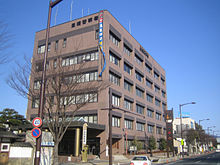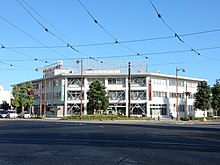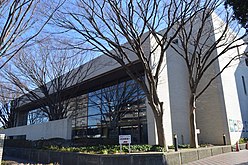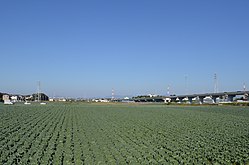|
Toyohashi
Toyohashi (豊橋市, Toyohashi-shi) is a city in Aichi Prefecture, Japan. As of 1 December 2019[update], the city had an estimated population of 377,453 in 160,516 households [1] and a population density of 1,400 persons per km2. The total area of the city was 261.86 square kilometres (101.10 sq mi). By area, Toyohashi was Aichi Prefecture's second-largest city until March 31, 2005, when it was surpassed by the city of Toyota, which had merged with six peripheral municipalities. GeographyToyohashi is located in southeastern Aichi Prefecture, and is the capital of the informal "Higashi-Mikawa Region" of the prefecture. It is bordered by Shizuoka Prefecture to the east, and by Mikawa Bay and the headlands of the Atsumi Peninsula to the west. To the south is the Enshū Sea of the Pacific Ocean. The presence of the warm Kuroshio Current offshore gives the city a temperate climate. The Katahama Jusan-ri Beach (片浜十三里) stretching in adjacent city of Tahara to the west, Toyohashi, and the city of Hamamatsu to the east is a sea turtle nesting spot. ClimateThe city has a climate characterized by hot and humid summers, and relatively mild winters (Köppen climate classification Cfa). The average annual temperature in Toyohashi is 16.3 °C (61.3 °F). The average annual rainfall is 1,651.3 mm (65.01 in) with September as the wettest month. The temperatures are highest on average in August, at around 27.5 °C (81.5 °F), and lowest in January, at around 5.4 °C (41.7 °F).[2]
Demographics Per Japanese census data,[4] the population of Toyohashi has grown steadily over the past 60 years.
Neighboring municipalitiesCity scape
HistoryOriginsThe area around present-day Toyohashi has been inhabited for many thousands of years. Archaeologists have found human remains from the Japanese Paleolithic period, which have been carbon dated to more than 10,000 BC along with the bones of Naumann elephants. Numerous remains from the Jōmon period, and especially from the Yayoi and Kofun periods have also been found, including many kofun burial mounds. During the Nara period, the area was assigned to Atsumi, Hoi and Yana Districts of Mikawa Province and prospered during subsequent periods as a post town on an important river crossing of the Tōkaidō connecting the capital with the eastern provinces. Sengoku periodDuring the Sengoku period, the area was a highly contested zone between the Imagawa clan based in Suruga Province and various local warlords, who built a number of fortifications in the area, including Yoshida Castle. The rising power of the Matsudaira clan and its alliance with Oda Nobunaga eventually neutralized the threat posed by the Imagawa, and the area became part of the holdings of Tokugawa Ieyasu. Following the Battle of Odawara in 1590, Toyotomi Hideyoshi ordered the Tokugawa clan to relocate to the Kantō region and assigned the castle to Ikeda Terumasa. Ikeda developed the surrounding castle town and embarked on a massive and ambitious plan to rebuild Yoshida Castle. However, following the Battle of Sekigahara, he was relocated to Himeji Castle. Edo periodAfter the establishment of the Tokugawa shogunate, Yoshida Castle became the center of Yoshida Domain, a clan fief. The domain was assigned to several different fudai daimyō clans until coming into the possession of the Matsudaira (Nagasawa-Ōkōchi) clan in 1752, which remained in residence at Yoshida until the Meiji Restoration. The final daimyō of Yoshida, Matsudaira Nobuhisa, surrendered the domain to the Meiji government in 1868. In 1869, the name of the domain was formally changed from Yoshida to Toyohashi. Meiji periodWith the establishment of the modern municipalities system under the Meiji government in 1879, Toyohashi Town was created within Atsumi District, Aichi Prefecture. Toyohashi Zoo was established in 1899. The town achieved city status in 1906. Taishō periodA tram system (the present-day Toyohashi Railway Asumadai Main Line) was established in 1925. Shōwa periodIn 1932, Toyohashi expanded its borders by annexing Shimoji Town (Hoi District), Takashi Village, Muroyoshida Village (Atsumi District), and Shimokawa Village (Yana District). Toyohashi suffered considerable damage during the 1944 Tōnankai earthquake, and even more damage during the Toyohashi Air Raid, which destroyed more than 60% of the city in June 1945. Modern ToyohashiIn 1955, Toyohashi's geographic extent was expanded again with the annexation of neighboring Maeshiba Village (Hoi District), Futagawa Village, Takatoyo Village, Oitsu Village (Atsumi District) and Ishimaki Village (Yana District). Toyohashi achieved core city status in 1999 with increased autonomy from the prefectural government. Government  Mayor-councilToyohashi has a mayor-council form of government with a directly elected mayor and a unicameral city legislature of 36 members. Prefectural AssemblyThe city contributes five members to the Aichi Prefectural Assembly. House of RepresentativesIn terms of national politics, the city is part of Aichi District15 of the lower house of the Diet of Japan. List of mayors of Toyohashi (from 1907)
PublicPolice
Firefighting
Health care
Post office
Library
International relations
Economy  Primary sector of the economyAgricultureSecondary sector of the economyIndustrial production is centered around the production of automotive-related components for Toyota, Mitsubishi, Suzuki Motors, and Honda, all of whom have factories in the region.
Tertiary sector of the economy
Mikawa Port is a major port for worldwide trade, and its presence has made Toyohashi the largest import and export hub in Japan for automobiles, in volume terms. Compared to other ports around the world, Mikawa is roughly on a par with the German port of Bremerhaven.[8]
MediaStudio
Newspaper
Education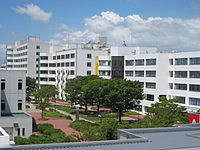  University
Primary and secondary schools
International schools
TransportationRailwayToyohashi Station is on the Tōkaidō Shinkansen and the Tōkaidō Main Line. Hikari shinkansen services stop at Toyohashi Station approximately once every two hours, and Kodama services stop twice an hour. Toyohashi Station is also the terminus of the Iida Line, Meitetsu Nagoya Main Line, Toyohashi Railroad Atsumi Line, and the Toyohashi Railroad Azumada Main Line, making it an important transportation hub. Highspeed railConventional lines
Tramway
BusAlmost all services are operated by Toyotetsu Bus, a subsidiary of Toyohashi Railroad. Roads HighwayJapan National Route
Sea port
Local attractionsPlaces of interest 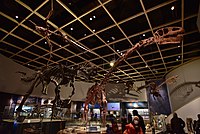 
Facilities and parksToyohashi has many parks, including the Natural History Museum and Zoological Park, the Imou swamp, Mikawa Seaside Forest, Kamo Iris Garden, and the Mukaiyama Ume Garden. It also has what is considered one of the best surfing beaches in Aichi and the surrounding region.[11] CultureFestivalsToyohashi Festival, Spring Festival, Iris Flower Festival, Gion Festival, Demon Festival (February), and traditional marionette performances (Akumi joruri). At some of these festivals, especially the summer festivals, the use of traditionally handcrafted fireworks is showcased, and include hand-held bamboo-tube fireworks known as tezutsu hanabi. Special productsChikuwa (a type of baked sausage roll made from fish), Gohei rice cake (五平餅, Gohei-mochi), beach fermented soybeans, food boiled in goby fish and soy, top producer of quail eggs in Japan, Toyohashi calligraphy brush (豊橋筆, Toyohashi-fude). In popular cultureIn the fictional Harry Potter universe, Toyohashi is the hometown of the professional Quidditch team, the Toyohashi Tengu.[12] In the Takeshi Kitano movie Kikujiro, the story revolves around the characters' trip from Tokyo to Toyohashi. Toyohashi is the setting of the light novel series Makeine: Too Many Losing Heroines!, the anime television adaptation of which premiered in July 2024. SportsBasketballBaseball
Gallery
Notable people from Toyohashi
See also
References
External linksWikimedia Commons has media related to Toyohashi, Aichi.
Information related to Toyohashi |
|||||||||||||||||||||||||||||||||||||||||||||||||||||||||||||||||||||||||||||||||||||||||||||||||||||||||||||||||||||||||||||||||||||||||||||||||||||||||||||||||||||||||||||||||||||||||||||||||||||||||||||||||||||||||||||||||||||||||||||||||||||||||||||||||||||||||||||||||||||||||||||||||||||
Portal di Ensiklopedia Dunia










